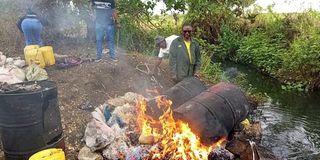
Many people maintain the rate at which they irrigate their parched throats with beers, wines and spirits, both legal and illegal.
News
Premium
A drinking nation: Lengths to which Kenyans will go to sustain consumption habits
For a country where the main concern now is the skyrocketing prices of basic commodities including food, the rate at which alcohol is faithfully consumed by millions tells another story altogether.
How the budget for alcohol consumption remains steady, with many bibulous people maintaining the rate at which they irrigate their parched throats with beers, wines and spirits, both legal and illegal, is a mystery at a time when many a household admits to struggling to afford food.
While those addicted to the bottle are shunned by society and often seen as hopeless, some of these individuals have, surprisingly, told the Nation that the tough economic times have pushed them further into debt as they struggle to maintain their drinking habits.
This is the case for Joseph*, a young man living in the informal settlement of Kibra, who spends most of his days at his favourite drinking spot in Lindi.
Often, he and his unemployed friends meet at their usual spot around 8am to discuss “serious politics and economic matters”.
They do this while waiting for "Mama Pima" to prepare their jugs of chang’aa, a popular distilled spirit that remains illegal in the country, but whose ubiquity in hundreds of places across the country calls into question the veracity of the policies that made it illegal.
They then spend most of the day and sometimes the night in the same place, building castles and telling tales, both true and false, in the hope that the extended drinking sessions will drown their sorrows.
Drinking den
If they had jobs, Joseph believes they would not be in the drinking den, struggling to raise just Sh50 to buy a cup of the liquor that each of them is determined to down. The liquor is sacred, they call it the holy water.
“We are here because we have no jobs, getting a job at the moment is a pipe dream. The cost of living is high, the government has abandoned us, the only way to survive is to come here, drink as much as you can and forget your troubles,” he said.
He is not the only one suffering from alcohol’s tentacles. Currently, one in eight Kenyans between the ages of 15 and 65, about 3.2 million people, including 2.5 million men, consume alcohol across the country. This is according to the latest survey conducted by the National Campaign Against Alcohol and Drugs Authority (Nacada).
The same report shows that the Western, Coastal and Central regions take the top three spots for the highest alcohol consumption, with 23.8 per cent, 13.9 per cent and 12.8 per cent respectively.
In April, Deputy President Rigathi Gachagua announced a total war on alcoholism in Central Kenya and held a meeting with leaders from the region to chart the way forward in tackling the menace.
During the Easter Sunday service at PCEA Ngorano Church in Mathira, the DP noted that the Mount Kenya region has borne the brunt of illicit brew and drug abuse. He attributed the high rate of drug abuse to the unregulated alcohol outlets and warned that if nothing was done, the region risked losing an entire generation to the menace, especially in the five counties of Central Kenya.
“If we don’t act now, a whole generation is at risk of being wiped out in the next 10 years. The President is equally concerned about this disturbing and sad situation and that is why I have convened a conference bringing together all leaders and security officials in the region,” the Deputy President said in a tweet.

Chang'aa brewers appear to have become innovative, using pits along river banks to prepare illicit liquor. Security officers in Nanyuki Town, Laikipia County found five containers with kangara in dug out pits along the banks of River Likii.
However, the problem of alcoholism persists in other parts of the country.
Shinyalu, in Kakamega County, is famous for its ability to produce chang’aa, and for the quality of its work, its prices are relatively high compared to others. Half a litre of this popular liquor sells for an average of Sh150, but there is a charge for any amount you can afford, including Sh10 for a bottle top shot.
The presence of many streams and dense vegetation provides water and wood for cooking, highly valued assets in the brewing of alcohol.
However, busaa, another traditional alcohol brewed in the western region, is slowly dying out, not because demand has dwindled, but simply because the price of maize, the main ingredient in the drink, has skyrocketed, forcing many brewers out of the once-lucrative business, one resident revealed.
In Kisumu County, the same chang’aa has many names, including achwakaa, and if you buy it in the smallest portion, a tiny tot of barely 30 millilitres, the name changes to changli, which sells for Sh20. The affordability of the alcohol helps the locals get through the tough economic times, with many admitting to passing out after a few shots, allowing them to easily skip lunch and dinner. The economy is too tough to imagine being sober at mealtimes.

A police operation to flush out illicit brews dealers along River Chania in Kiambu.
“Pombe ni cheap kuliko hata unga na sukari...na pombe iko na sukari (Alcohol is cheaper than flour or sugar, and has sugar in it),” said Omolo*, a resident of Manyatta, Kisumu County.
This is not only the case in Manyatta, but also in the areas of Kondele, Mamboleo and a famous bar on Kisumu’s Main Stage called Mama Olga.
To be clear, it is not only the unemployed and the penniless who turn to alcohol to “numb the pain of reality”. A recent survey conducted by Nacada on the status of alcohol and drug abuse among workers in the public sector in Kenya showed that the prevalence of alcohol use among workers was 23.8 per cent. An analysis of alcohol use disorders among this study group stood at 13.2 per cent, meaning 89,127 employees had an alcohol use disorder (AUD).
“Further categorisation of AUDs by severity showed that 5.7 per cent (38,487) had a mild alcohol use disorder, three per cent (20,256) had a moderate AUD while 4.5 per cent (30,384) had a severe AUD,” reads part of the report.
Prof John Muteti, acting CEO of Nacada, noted that alcohol consumption by public sector workers was more than double the national average of 11.8 per cent, which has implications for workforce performance.
“We suspect that because these people have disposable income, they can afford alcohol. Another interesting thing is that the highly paid public service institutions such as the Kenya Ports Authority and the Kenya Revenue Authority have an even worse problem, followed by the police,” he said.
Bad situation
The situation among police officers is so bad that Prof Muteti described it as alarming, with more officers registering very high rates of alcohol consumption. In his analysis of the drinking habits of law enforcement officers, the Nacada boss believes that the tough nature of their job, coupled with their low salaries in the midst of tough economic times, drives them to relieve their stress with the bottle.
In Nairobi, Nacada notes that the availability of liquor stores within stages and termini is exacerbating the drinking menace and interestingly, several hotspots mapped by the authority serve not only chang’aa but also the famous keg, narcotic drugs, beers, wines and spirits.

A chang'aa brewing den on an artificial island in Lake Victoria on December 11, 2021.
The listed hotspots in and around Nairobi — Donholm (chang’aa), Kayole junction (keg), Hakati bus station where 60 per cent of the stalls sell wines and spirits, Mfangano (hard drugs and alcohol), Muthurwa (chang’aa, bhang, hard drugs and alcohol), Ruga Ruga (chang’aa and alcohol), Easy Coach stage, Mlolongo, Cabanas, Mwiki Kwa Maina, Njiru and the Eastern bypass — are notorious for alcohol.
However, Odeon, Moi Lane and Kangemi Bus Stage easily offer chang’aa and cheap alcohol, with the latter available at Dagoretti Corner, Kawangware, Karen Stage, Bulbul and Ngong towns, as well as along the Westlands-Kangemi-Thiongo road, Uthiru, 87 and Kinoo.
Nakuru County, according to a July 2023 mapping by Nacada, has hundreds of illegal brewery dens in its various sub-counties of Nakuru West and the towns of Mutamaiyo, Arimi, Kapsita, Marioshoni, Ndoswa, Chandera, Turi, Kiambiriria, Molo and Sachangwan.
Bomet County is not far behind with hotspots recorded in Morit sub-location, Silibwet, Ebekwet, Tabarin, Noreiya, Koibeiyon and Mogoma villages and several others in Konoin and Sotik subcounties.
Narok, Laikipia, Samburu, Kajiado and Kericho counties have a total of more than 200 illegal breweries.
Psychologist Arthur Gichuru explained a well-established theory — that when times are tough, whether emotionally, physically or economically, the human brain triggers the adrenal glands to produce cortisol, the stress hormone.
This hormone supports the fight-or-flight response to stress. This body’s stress response is usually self-limiting and once the threatening event has passed, cortisol levels return to normal.
Stress hormone
However, if the stressor is always present, the person will always feel threatened and the fight-or-flight response will always be on, Mr Gichuru said.
“Since financial needs are mostly recurrent and ongoing, people with financial problems are constantly on a high-stress level and this puts them at risk of problems such as chronic stress, anxiety, depression, and sleep problems,” he said.
These adverse situations force them to seek solutions to their problems, and this is when most people turn to drugs to try to relieve the negative feelings.
"Drugs, including alcohol and nicotine, are known to cause the body to produce dopamine (the feel-good hormone), which, when produced, makes the user feel happy. The hormone triggers the brain to produce large amounts of dopamine in a very short time.
"So this person finds an easier way to be happy by using drugs. Over time, the user develops dependence and tolerance, leading to addiction, and it becomes difficult for them to function without their drug of choice," he said.





